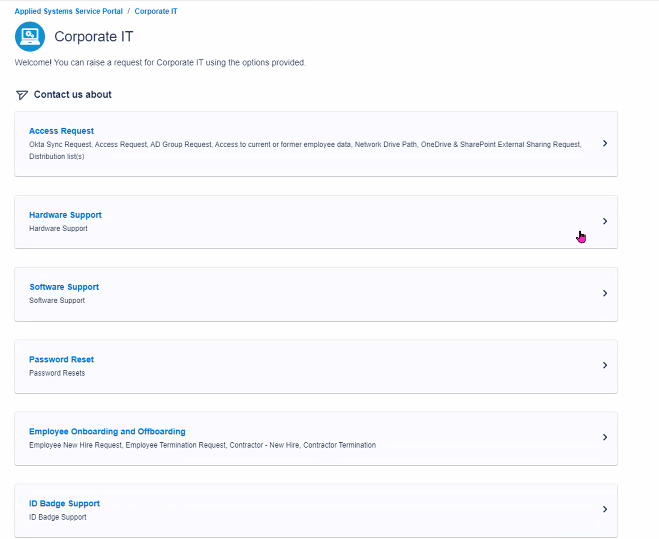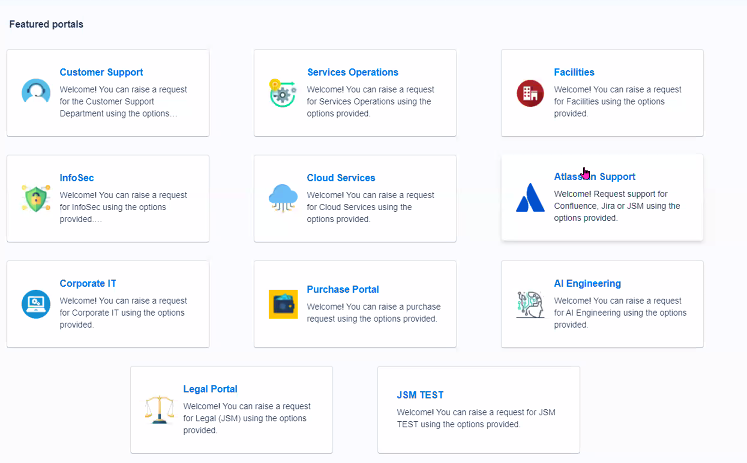How Applied Systems improved SLA success rates by 30% and hit 4.9/5 CSATs in two days by switching to Jira Service Management

With our prior tool, procurement requests would get stuck with manager approval. With Jira Service Management, the biggest win is transparency. People know where their issue is and when it's being resolved.
Bill Hall
Director of IT, Applied Systems
98%
Service-level agreement success rate, up from 75%
4.9/5
CSAT score after switching to Jira Service Management
80%+
Time saved on reporting with Jira Service Management

About Applied Systems
For more than 40 years, Applied Systems has created innovative technology for the global insurance industry. Today, they are a cloud software leader, revolutionizing the way insurance agencies and brokers succeed. Applied Systems champions bold thinking to transform a complex industry through digitization, automation, and innovative partnerships.
Challenge: Applied Systems' previous service management toolstack was hindering efficiency, collaboration, visibility, and service between Development and Operations teams
Solution: The company expanded their use of Jira and Confluence cloud by adding Jira Service Management Cloud for IT and business teams' enterprise service management
Impact: Switching to Jira Service Management and centralizing with Atlassian Cloud Premium tools helped Applied Systems increase collaboration, visibility, speed, and satisfaction
An insurance software innovator seeks a leading ITSM solution
For more than four decades, Applied Systems has been revolutionizing the insurance industry through digitization and automation. A first mover within their sector, Applied Systems’ comprehensive software tools enable insurance brokers and agencies to manage nearly every aspect of their business in the cloud.
Innovation and development is core to Applied Systems’ brand DNA. As they looked to modernize their IT service management practices, their team knew they wanted a flexible, adaptable platform that would feel fluent with this forward-thinking philosophy.
Jira Service Management’s flexible, scalable approach immediately stood out to Applied System’s IT leaders. They also knew it would ease cross-functional collaboration — Atlassian has been an integral part of Applied Systems’ infrastructure since 2019, starting with Jira for product development. Today, every Applied Systems employee is an Atlassian Cloud Premium user, and Jira and Confluence are the standard for operations, project management, and development across the organization.
To manage internal IT and business-related requests, Applied Systems transitioned from another popular ITSM solution to Jira Service Management. Today, they use Jira Service Management for incident, request, change, and asset management across ten different business units, including IT Support, Engineering, Customer Support, Operations, Legal, Procurement, and more. Each unit encompasses multiple teams, who all use custom dashboards and processes to determine their own most powerful way of working.
Since adding Jira Service Management to their Atlassian ecosystem, Applied Systems’ teams are effortlessly tracking tickets across platforms, building custom projects for their unique needs, and meeting service-level agreements at a higher rate. The result? Smoother collaboration, less frustrating tool-switching, and an improved workplace experience across Applied Systems’ teams.
The goal: Get tickets out of the “black hole” with a flexible, collaborative ITSM solution
Before switching to Jira Service Management, Applied Systems’ tool stack was fragmented. Customer-facing teams used Salesforce, development teams used Jira, and IT operations used another tool to handle ITSM flows (like incident management and service requests) and internal processes (like onboarding and procurement).
These siloes caused significant challenges with cross-team collaboration due to the difficulty of tracking requests as they flowed through multiple systems — often getting stuck in the company’s legacy ITSM tool.
“My biggest frustration was that you’d put in a ticket, and it was like it went into a black hole,” explains Director of IT Bill Hall. “There wasn’t even an easy way to speak to anyone about the ticket. We’d end up just reaching out informally to people we knew who worked in the relevant department.”
Further complicating the situation, some internal tickets were submitted on behalf of customers, like feature requests gleaned in sales calls. “It was a nightmare for individuals,” says Bill. “A customer issue or request would get fielded by somebody in Salesforce. The development team would do the work in Jira. Once the fix was ready for deployment, it would go into a ticket in the ITSM tool for operations. But the person who originally interacted with the customer is tracking tickets across three systems and thinking, ‘I reported this bug weeks ago. Where are we at?’”
Applied Systems also found it time- and cost-prohibitive to customize forms, workflows, and reports. All requests for changes and customizations went to Bill’s team, and they couldn’t justify the additional resources and overhead it would take to fulfill them. “To get the most out of our previous tool, we would have needed to invest in a small team for maintenance and support, and we didn’t have that,” Bill says.
Applied Systems outsourced some development work and fielded other requests internally, but it felt like trying to stop a rising tide. “I was leveraging help desk folks in their free time, but we were generating a huge backlog,” Bill explains. “We were having difficulty driving the efficiency we needed.”
Bill and his team simply couldn’t get what they needed from the legacy system in a cost-effective way. Adding urgency, Applied Systems’ IT Team was growing, and they also wanted to expand their ITIL practices, including implementing a Configuration Management Database (CMDB) to organize their hardware and software assets.
IT’s backlog of work was growing, and headcount requests to properly manage the tool were not being approved year over year. They knew it was time for change and transformation. “We needed to start evolving our ITSM processes,” Bill says. “As we looked into what it would cost to do that on our prior system, we realized it would be extremely expensive.”
An easily customized solution, empowering teams to work they want
Teams across Applied Systems already relied on Jira and Confluence — in particular, Jira is an indispensable core tool for Product and Development teams. So even though the IT team considered other options, Jira Service Management was the clear choice for modernizing IT service management.
“We had a strong investment in Jira already for development and project management,” says Bill. “Reducing the number of tools our teams worked in would drive efficiencies, making interactions between operations and development a lot easier.”
As they got closer to the renewal period for their existing system, Applied Systems’ teams saw an opportunity — reduce their headaches and improve service delivery by going all in on the Atlassian platform.
Jira Service Management: an open-platform approach to service management
Out of the box, Jira Service Management met 80-90% of Applied Systems’ needs. Then, teams leveraged Atlassian’s robust Marketplace and API integrations to get even more value out of the platform.
“We were really attracted to Atlassian’s open platform approach. They’re not trying to solve every IT problem themselves,” says Bill. “Jira Service Management meets all of our core needs, and we can also select the best external solutions for our needs and easily integrate them.”
This flexible structure is a world away from Applied Systems' previous rigid, prescriptive ITSM experience. “We love the speed in which fulfiller teams can make the changes they need for their own workflows,” Bill says. “We’ve empowered business teams to easily manage their front-end service portal, create their own reports, set up integrations into their Jira projects, and create simple automations to streamline their processes — all with minimal training.”
Within Bill’s own Corporate IT Team, Jira Service Management’s Okta integration automatically assigns tasks and sends requests to the right person. When tasks or approvals get stuck, an automatic reminder system minimizes delays and helps teams meet SLAs.

With Jira Service Management, Applied Systems has also been able to achieve their goal of expanding their ITIL practices. They are using Jira Service Management for service request, incident, change, asset, and alert/on-call management. Jira Service Management’s Assets have been particularly helpful for robust yet cost-efficient infrastructure planning and insights, such as tracking endpoints, ownership, and configuration.
Adapting Jira Service Management to unique team and business needs
Applied Systems was excited by Jira Service Management’s simple customization options and robust integration capabilities with both Atlassian and external platforms. Now, users don’t need to open many different tools to get work done – they’re equipped with everything they need as soon as they open the portal.
Applied Systems’ internal team of Atlassian experts, led by Director of Enterprise Applications Sonya Petkunas, built custom service desks for each team, along with custom dashboards that bring together information from Jira, Jira Service Management, and Confluence, and empower them to handle their own core tasks, reporting, and automation independently. Teams using Jira Service Management include IT support, Customer support, procurement, security, engineering, customer operations, facilities, legal, and services organizations.
“What we're trying to do is have just one place that employees go to see the information they want in an easily consumable fashion,” Bill explains. “Teams are capable of handling all their day-to-day activities within the portal, and can make 70% of the changes they need quickly and independently.”
“An employee dashboard might pull in all the Jira and Jira Service Management tickets they need to work on,” explains Bill. “Upper-level managers might see a Confluence page with all high-level projects and metrics that show how they’re going.” Teams can then adjust the desks and dashboards on their own or lean on Sonya’s team for advanced changes.

Purchase portal: fully customized procurement with Jira Service Management
Applied Systems’ new procurement process, or “Purchase Portal,” is one highly customized project made possible with Jira Service Management. This is a designated desk for all kinds of employee procurement requests, from software licenses to laptops to business cards.
After these requests come in, they follow a complex, custom workflow, which triages them across three teams — Corporate IT, Customer-facing IT, and Facilities. Then, the request moves through different levels of required approval. First, a pre-approval team assesses if any existing resources could meet the employee request. Then, different levels of management are authorized to approve requests above certain thresholds, like $1,000 or $5,000. Approvals are even vetted by Finance to ensure budget is available, and suggest places to cut back if it’s not.
This is a much more visible, transparent process than was possible before Jira Service Management, and it helps ensure Applied Systems’ compliance as an IO/SOC audited company. “With our prior tool, procurement requests would get stuck with manager approval,” says Bill. “On Jira Service Management, the biggest win for most people is the transparency of knowing where their issue is, when it’s being resolved."
Beyond the “black hole”: a new world of visibility, efficiency, and seamless collaboration
Across Applied Systems, implementing Jira Service Management and expanding the use of other Atlassian tools has created unprecedented visibility, driving greater efficiency and collaboration. Because every ticket is tracked across systems, employees no longer feel like they’re sending requests into a black hole. “People can see where things are and who’s accountable to move them forward,” explains Bill.
By implementing Jira Service Management, Applied Systems was able to segment requests into visibility into Tier 1 and Tier 2 urgency, giving them visibility into where changes were needed for faster resolution. Within two days of launching the tiered system, Tier 1 and Tier 2 SLA response metrics improved dramatically, rising from 75% to 98%. They also reached an average customer satisfaction score of 4.9/5 — a marked change from the legacy system, which teams found stressful and disruptive.
Now that they have a single source of truth for data and request history, reporting is also easier. “In the past, it would take 40 to 50 hours of tracking things down in email or Slack to figure out what we spent that year,” says Bill. “Now, the year’s purchase order and invoice numbers are stored within our Purchase Portal [powered by Jira Service Management], so annual reporting takes me one day.”
The customized employee dashboards enhance this visibility even further, giving workers and managers instant feedback on how their work is going. Across the company, Sonya has seen this access to data transform how decisions are made. “Because we've got these dashboards showing us in real time how we're performing, we can come to the CIO or CTO with good stories and sound proposals, backed with data,” she says. “It really levels the playing field. We’re moving from a feel-based toward a data-based management and operation structure.”
Moving forward, Applied Systems plans to implement Atlassian Intelligence to further streamline their processes and help people access information in their Confluence knowledge base more easily. Across the business, more and more units want to integrate their Atlassian tools, so the team is continuing to build more unique, customized workflows. “Someone may get a ticket in Salesforce or JSM, but want to work on it in Jira,” says Sonya. “We’re constantly testing ways to get people the information they need, where they need it.”

About Applied Systems
For more than 40 years, Applied Systems has created innovative technology for the global insurance industry. Today, they are a cloud software leader, revolutionizing the way insurance agencies and brokers succeed. Applied Systems champions bold thinking to transform a complex industry through digitization, automation, and innovative partnerships.
Industry
Software
Number of users
2700
Location
United States
Check these out

